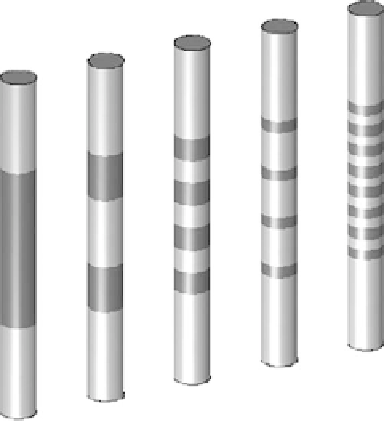Biomedical Engineering Reference
In-Depth Information
brain stimulation. The distribution of potential as a function of time and space
is calculated for a range of stimulus waveforms and then applied to the model
of myelinated axons to determine neural activation. Electrode geometry is also
essential. Even though the different target nuclei offer considerable differences
in their anatomical structure, only limited types of electrodes are currently
available. Microwires, glass electrodes, polymer electrodes and silicon micro-
machined array of electrodes are the most popular. For example, metallic
electrodes consist of four cylindrical contacts with a height of 1.5mm and a
diameter of 1.27mm. The distance between the contacts is 0.5 or 1.5mm. The
contacts can be activated separately, and the two commonly used approaches
are monopolar and bipolar stimulation. Monopolar stimulation causes a wider
distribution of the current in all directions in contrast to bipolar stimulation
where the current flows between the activated contacts and stimulates a more
restricted area. Segmented electrodes with different active surface areas
distribution as shown in Figure 6.4 have been investigated.
17
The effects of amplitude, frequency and pulse width have been further
investigated for an ecient stimulation.
18
Figure 6.5 illustrates the computer
modeling of the representation of the spatial voltage of a DBS electrode used
for the treatment of Parkinson's disease. The electrodes are inserted in the
subthalamic nucleus. Microelectrode recordings are utilized to ensure accurate
placement of the stimulating electrodes in the target tissue. The clinical changes
seen with DBS in Parkinson's disease are consistently beneficial but, again,
there continues to be only marginal understanding of the mechanisms by
which DBS achieves these results. Analytical models of the DBS four-contact
electrodes have been developed.
18
Using software developed to simulate
d
n
4
t
3
n
g
|
2
n
3
.
Figure 6.4
Different types of implantable segmented electrodes.
17
(Reprinted with kind permission of the Institute of Physics Publishing.)

